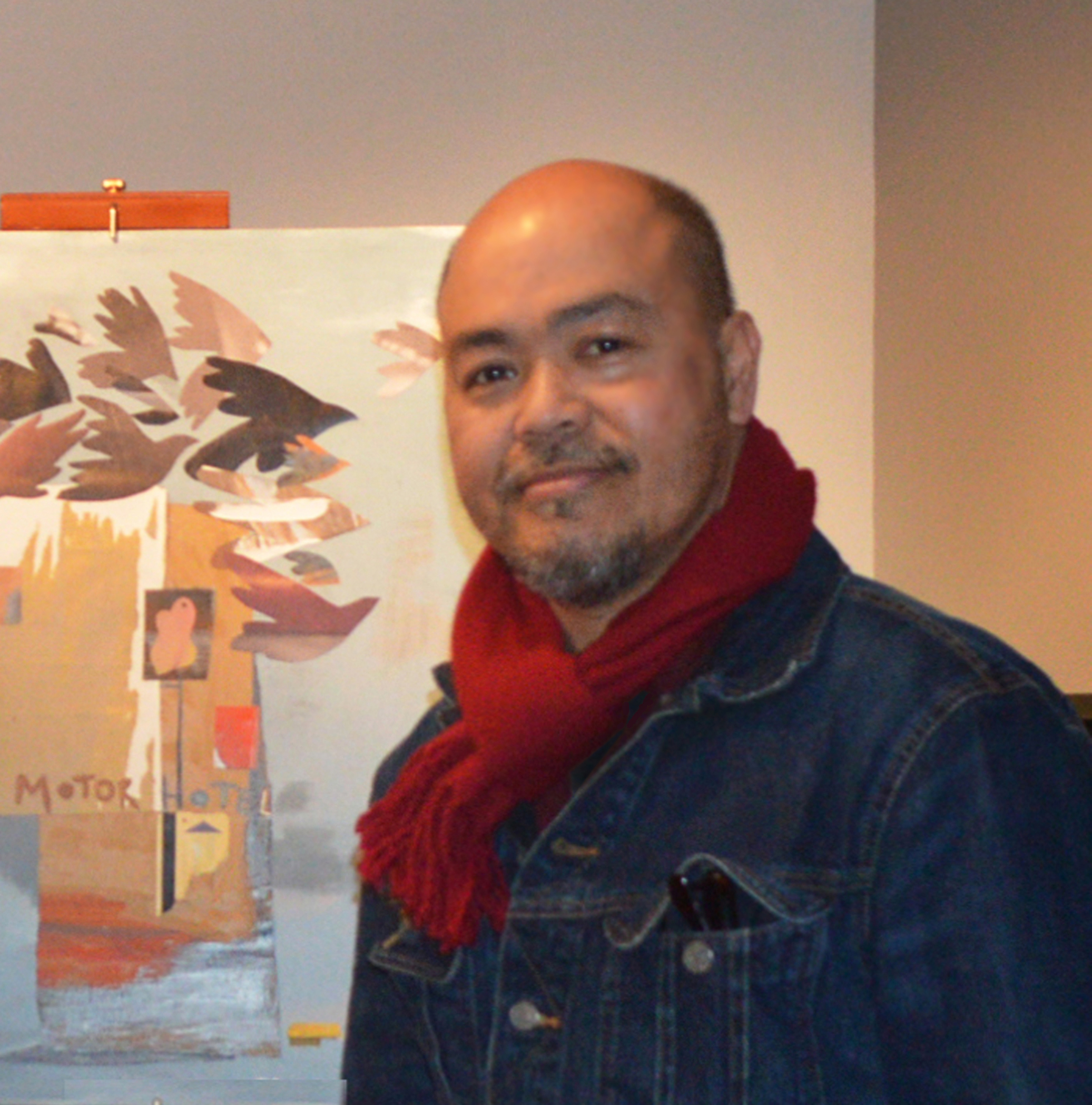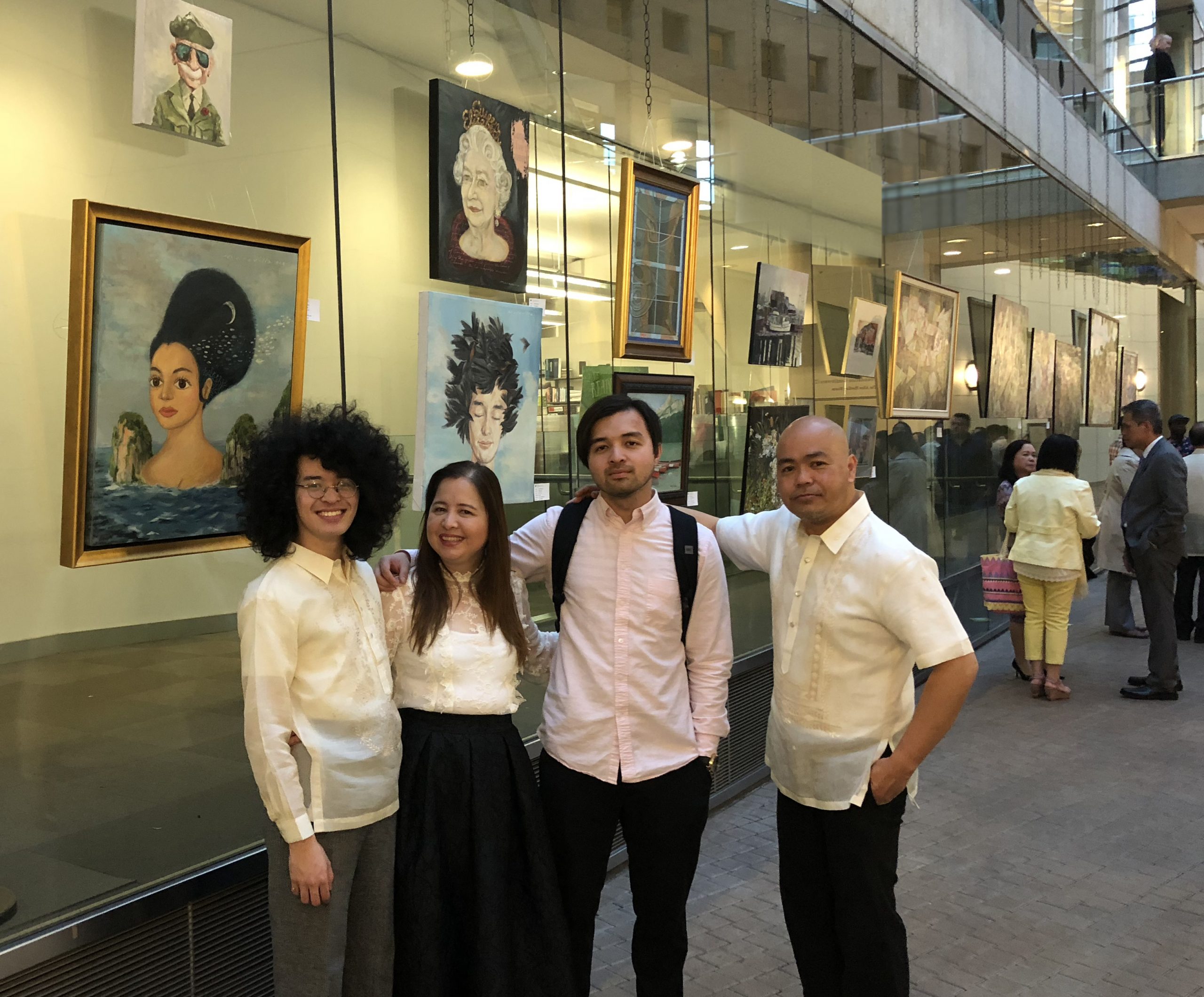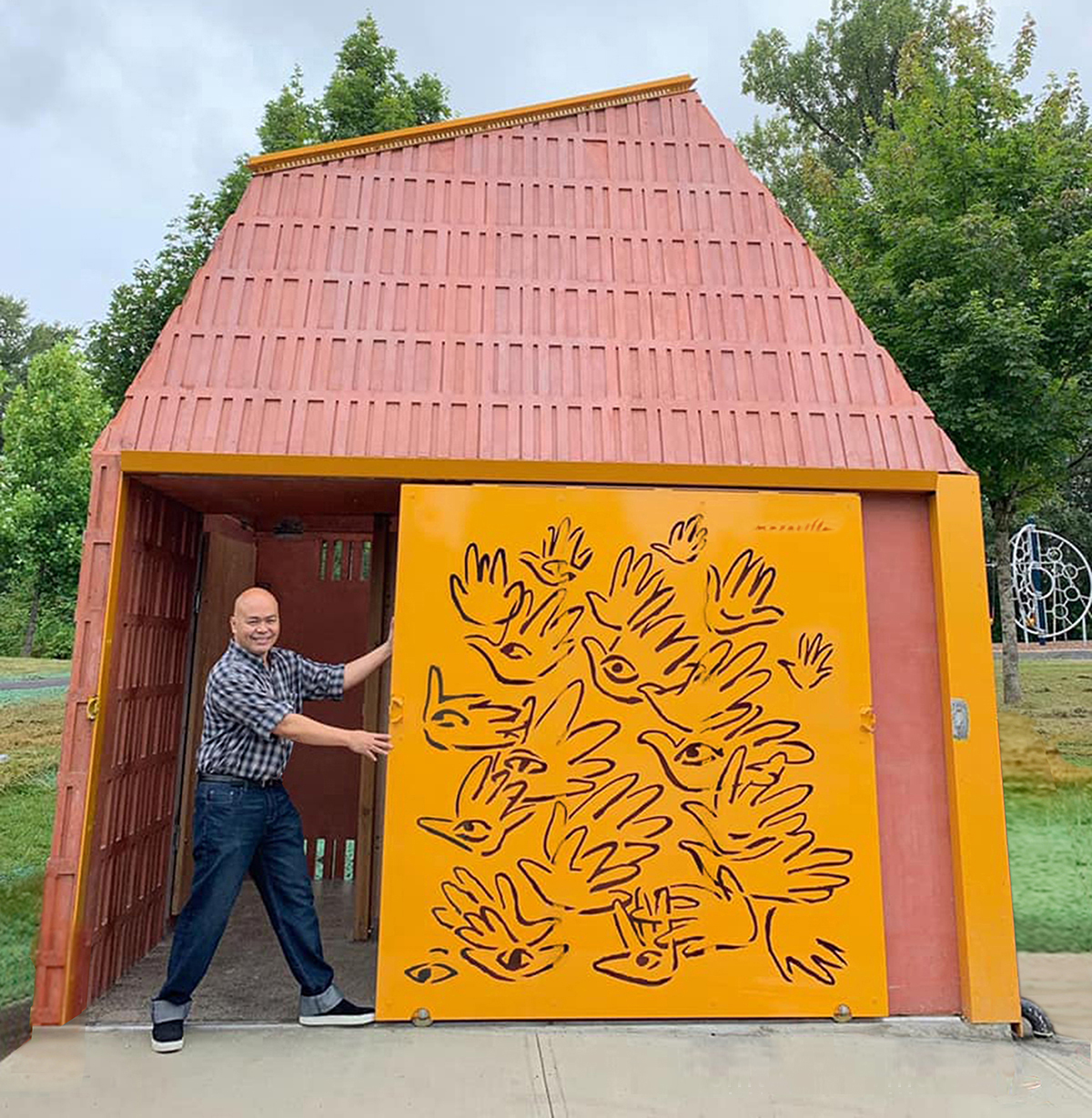Filipino-Canadian In Focus
Chito Maravilla and his stories told through paintings
- Chito at the Fundraising event exhibit for Richmond Care, Richmond Gives (RCRG) in 2017 (Supplied)
- Chito with his family at Dimasalang III exhibit at the Vancouver Public Library in 2018. (Supplied)
- Chito’s public art by the City of Surrey for Maple Green Park in Surrey, BC in 2019. (Supplied)
Each of us has stories to tell or messages to convey to one another in various ways. Some choose to share it through a casual conversation, while others do it via writing, perhaps on paper or with the use of technology.
While these people are used to expressing what’s in their minds through words, some prefer to share their narratives in a way by drawing others into the frame and hopefully get across the message they are trying to express through lines and shapes of a particular image.
Through his artworks drawn in a variety of styles, visual artist Chito Maravilla gets to choose what story and emotion he wants to convey — may it be of joy, of pain, or of hope — to his audience.
From pastime to passion
Chito’s way of sharing his narratives started off as a fun pastime of a grade-schooler who was then attending school in Manila.
Born and raised by an operations manager of a shipping line and a government accountant, Chito is the fifth child from the eldest among the seven children, four girls and three boys, and is the only one who grew up to be an artist in the family. His passion for art began during his early elementary years, when he would draw the entire afternoon at his mom’s office after class, waiting to be picked up by his dad to go home.
Perhaps doing this every after school, Chito subconsciously developed a hobby, which in due course, advanced his illustration skills. With this, he started to join inter-school art competitions and bring home awards. Recognizing his talent and wanting him to enhance it more, Chito’s mother decided to enroll him in a Summer Art Workshop at the Cultural Center of the Philippines, wherein he was exposed to contemporary and abstract art that opened his eyes to a different level of appreciating and understanding art.
Continuing to learn about his craft, Chito’s artworks got a lot better each day and by the time he was taking his Bachelor’s degree in Fine Arts Major in Advertising at the University of Santo Tomas, his sketches already became outstanding.
But there’s still a thing that’s lacking: his own style of sketching. Chito said that during that time, he had not developed his style yet. It was not until he worked in an advertising agency after he graduated in college that he became “loose” with his style.
“I discovered the beauty in imperfections and the grace and elegance of spontaneity. I still don’t have a clearly specific style like most artists do and there’s nothing wrong with that.”
Chito shared that his style changes from time to time. There were days that he would want his illustrations to be drawn in abstract worlds, but there were times that he preferred it to be completely realistic.
“I believe it was the training and experience I gained in advertising, [and] that each day is different. Today will be milk ads, and tomorrow a beer commercial. I’m like that. I change channels all the time. I don’t want to be pigeon-holed to a specific style. I just want to tell a story, but it’s funny when people say they know that it’s a Maravilla.”
Chito enjoyed his job at the ad agency until the time came when he had to leave not only his work but also the country where he grew up in.
Fulfilling the Canadian dream
Chito, along with his wife and two kids, continued the next chapter of his life in Canada as they migrated there in 2002. No particular reason for moving has been said, except it was his wife’s “bright idea.”
Unlike his wife, Jenny, who was too focused on migrating, Chito was more talk but less action because he loved his job in Manila, but Jenny successfully convinced him to leave by showing him a signed document which showed that he was the “approved primary sponsor of fulfilling the Canadian dream.”
Living the “Canadian dream” for Chito and his family is being fortunate enough to have privilege in living both in the Philippines and Canada, even though they continue to face challenges along their way.
Their first days in Canada were exciting but were also an eye-opener for all of them; living in a new city where they do not know anyone aside from themselves gave a genuine opportunity to the Maravilla family to start a new adventure in their lives.
Beginning a new life in an unfamiliar place was, of course, never easy and may be coupled with that exciting feeling in the gut with a bundle of nerves. It is inevitable to encounter some roadblocks and battles along the way that will try to throw one off, and in Chito’s case, it was applying for work and experiencing discrimination.
While he had a nice job in the Philippines, it was hard for him to look for a job in Canada which he thought would fit him best like the one he had back home. But making a comparison between what was in his new home and what was in Manila did not do anything good for him so he stopped and said that everything went better after he did that.
Chito also acknowledged that apart from dealing with the difficult job hunt, another challenge that some immigrants in Canada have to deal with is being discriminated against because of their racial roots.
“It’s sad that these conflicts still exist. Some people seem so mean, for such awful reasons.”
Although he did not experience it, Chito, as someone who advocates for diversity and equality, said, “if push comes to shove, I fight back.”
Fortunately, he said millennials are becoming more accepting of this diversity. Chito shared that it is fun to watch that a lot of kids today are engaging and building relationships with another from a different race, regardless of their color, culture, and beliefs.
Although now a Canadian citizen, Chito said he is proud to have been born as a Filipino, so proud that he and his wife passed on their Christian faith and connection to communities and cultures from the Philippines to their children.
He also participates in some organizations and projects organized by Filipinos such as the Filipino Music and Art Foundation and The Dimasalang III art events. His family members are also active parishioners and volunteers of the Our Lady of Good Counsel church in Surrey and they support many of the events being hosted there, of which many of those are dedicated to foster and encourage the growing Filipino community.
Chito is grateful that he had the chance to experience a wonderful life in the Philippines and be privileged enough to live another exciting life in Canada and continue his passion for art.
Designer slash painter
Even when his job search was not as easy and quick as others, he was blessed to land on a job that is in line with his interests and skills. Chito got his first job there as a playground designer whose works were installed widespread in Canada and in the United States. As a playground designer, his everyday work did not just revolve around his position title. Trained in various fields as well, he gained a new and useful skill such as sculpting and carving playground character features and interactive child-friendly objects which helped him grow his career.
After five years, Chito ended what he called a “kind of a dream job” for him to be a full-time graphic designer at Smartfilms. His day-to-day work there includes doing large prints for window films for corporate institutions, printing and cutting signs and creating murals for commercial purposes, and sometimes being assigned to install those murals.
But outside his office, he also got a part-time job — but he’s not exactly doing it to further boost his income. Chito said his work at Smartfilms enables him to provide his family’s basic needs and pay their daily bills, and that he gets a more satisfying feeling when people recognize his exceptional work.
“It’s fulfilling that when you enter an establishment, you can point your finger and say to someone, ‘That whole glass feature of the hotel was done by us and our company.’”
But Chito thinks it was not only his stomach and his bank account that needed to be filled; his “soul” also had to be fed through making art so he decided to be a part-time painter this time.
“It’s mainly rediscovering who I am and what I want [to] express. There are no bosses or clients to please, no rules to follow except pure creative madness, but also to reach out and connect.”
Chito takes his inspiration from the things around him and the people he met. He shared that a lot of artists have influenced him big time such as the one and only Pablo Picasso, Jackson Pollock, Jean-Michel Basquiat, and Hieronymus Bosch, who, for him, were revolutionary in their works. They may no longer live, but the legacy they left behind will go down forever in history.
Aside from these painters, he also looks up to filmmakers like Luc Besson who is known for his thriller and action movies, and architects like Frank Gehry whose masterpieces have become world-renowned attractions.
Their crafts, Chito said, have truly inspired him, but there is this group of artists that “personally honed” him: it is the same people whom he had worked with at the advertising agency back in Manila.
“One person in particular [is] Sir Gil Corcuera. He taught me in many ways how art truly communicates.”
Dedicating most of his life making art, Chito experienced both the highs and the lows of being a visual artist.
He already encountered, and for sure will meet again sometime in the future, fickle-minded clients, copycat customers, demanding clients but don’t know what they really want, and those who undervalue an artist’s work.
The negativities thrown at him, however, do not compare to the greatness of the result of his craft. Throughout his career, he has been getting a lot of awards and recognitions, with his works being displayed in places such as the Vancouver International Airport, Surrey Art Centre, Surrey Art Gallery, and Lipont Centre in Richmond. Among his accolades was when he was awarded by the City of Surrey in 2018 for his two art installation designs which were built in 2019 for Maple Green Park.
“I am humbled and grateful that it was awarded to me. It is like a monument of a lifetime for me. For as long as the building is there, my art will be forever.”
But above all these acknowledgments, Chito believes the best part of being a visual artist is that everything he imagines in his mind becomes real.
“It could be a simple sketch made to become a corporate logo, or a storyboard concept animation, later produced as a TV commercial for Del Monte juice drinks, or a long stretch of a mural made to cheer up sick children in the British Columbia Children’s Hospital, or even simply a personal painting appreciated by a family all the way in Melbourne, Australia.”
Chito has been turning a make-believe world into reality since he was a kid. From making his childhood dream to become a visual artist happen, people have since seen his thoughts with their bare eyes through his crafts.
For Chito, making art is not just his burning passion; it is as well something that “nourishes” him and makes him “powerful.” Perhaps a few years from now, even though he has more wrinkles and gray hair by that time, Chito would still be documenting and surprising us with plenty of his stories, dreams, and imaginations he brought forth into actual masterpieces.
























